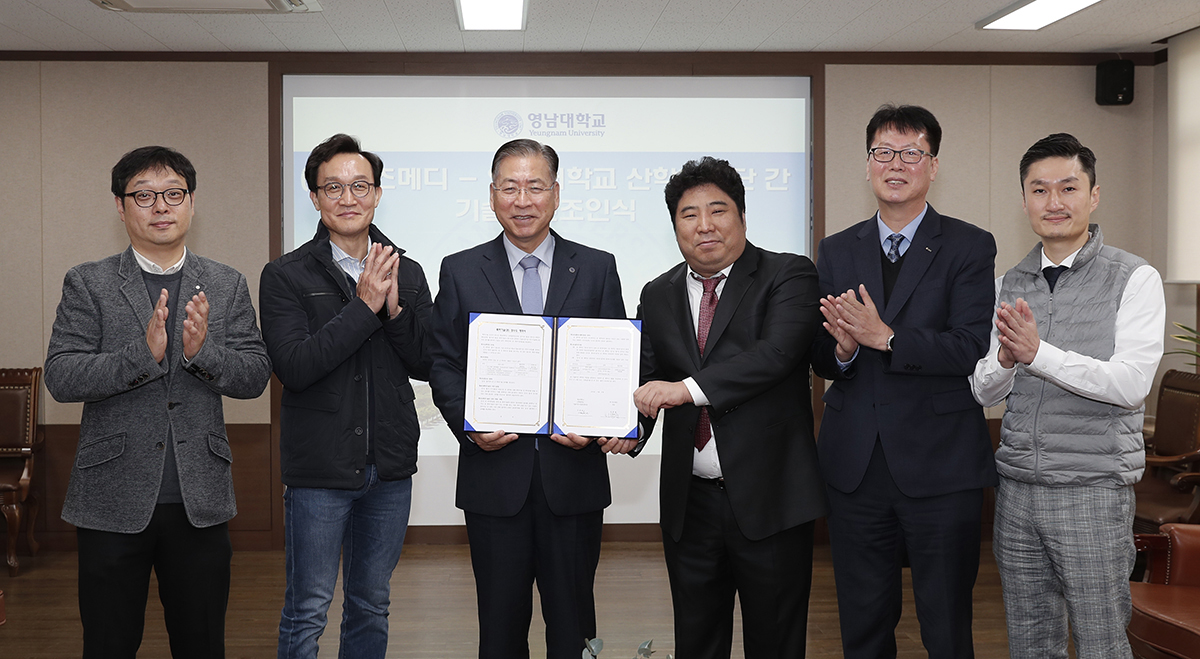YU Transfers ‘Whitening Cosmetic Manufacturing Technology’ N
No.89209- Writer pr
- Date : 2019.12.26 16:04
- Views : 8250
Food Science and Technology Professor Han Gi-dong develops ‘whitening cosmetic manufacturing technology using persimmon fermented extracts’
Prevention of leukoplakia, freckles... technology transfer wort 110 million KRW with Wizmedi
YU supports early commercialization through industry-academic cooperation
[December 17, 2019]

<The ‘whitening cosmetic manufacturing technology using persimmon fermented extracts’ will be transferred to companies for commercialization>
(from left to right: YU Tech Transfer Commercialization Center Director Lee Hee-yong, Food Science and Technology Professor Han Gi-dong, YU President Sur Gil-soo, Wizmedi CEO Choi Yong-hoon, Korea Technology Finance Corporation Daegu Technology Innovation Center Regional Director Choi Gi-jin, Wizmedi co-CEO Han Yoon-soo)
The technology transferred to companies is on ‘whitening cosmetic ingredient compounds’ including persimmon fermented extracts’ developed by YU Department of Food Science and Technology Professor Han Gi-dong. YU signed a technology transfer contract with Wizmedi (CEO Choi Yong-hoon, Han Yoon-soo) on the 10th. This technology transfer signing ceremony was attended by YU President Sur Gil-soo, co-CEOs of Wizmedi Choi Yong-hoon and Han Yoon-soo, Korea Technology Finance Corporation Daegu Technology Innovation Center Regional Director Choi Gi-jin, YU Tech Transfer Commercialization Center Director Lee Hee-yong, and Food Science and Technology Professor Han Gi-dong.
At the signing ceremony, YU President Sur Gil-soo stated, “Light is now being shed on the technologies and research capacities of YU by being transferred to a company,” and added, “Through continuous industry-academic cooperation, YU will take the lead in creating new growth engines where the university, companies and communicate can growth together.” YU Tech Transfer Commercialization Center Director Lee Hee-yong said, “The Tech Transfer Commercialization Center will offer continuous support to companies so that it can be commercialized in products early on.
The technology being transferred is technology for manufacturing whitening cosmetic products using persimmon fermented extracts, and unlike existing technologies, it is not applied directly on tryosinase and therefore, it can prevent side effects such as leukoplakia and freckles. As the K-beauty industry is growing rapidly in China and Southeast Asia, it is expected that the company receiving this technology transfer will be able to create whitening cosmetic product markets and increase revenue.
At the signing ceremony, YU President Sur Gil-soo stated, “Light is now being shed on the technologies and research capacities of YU by being transferred to a company,” and added, “Through continuous industry-academic cooperation, YU will take the lead in creating new growth engines where the university, companies and communicate can growth together.” YU Tech Transfer Commercialization Center Director Lee Hee-yong said, “The Tech Transfer Commercialization Center will offer continuous support to companies so that it can be commercialized in products early on.
The technology being transferred is technology for manufacturing whitening cosmetic products using persimmon fermented extracts, and unlike existing technologies, it is not applied directly on tryosinase and therefore, it can prevent side effects such as leukoplakia and freckles. As the K-beauty industry is growing rapidly in China and Southeast Asia, it is expected that the company receiving this technology transfer will be able to create whitening cosmetic product markets and increase revenue.
Food Science and Technology Professor Han Gi-dong, who is the principal inventor of this technology, said, “It is fulfilling to see that research on practical technologies reaped achievements. I hope to continue to contribution to the university, companies and community through research that can be of help to the food and bio industry.”
Wizmedi CEO Choi Yong-hoon said, “I would like to thank YU and the researcher for transferring this outstanding research outcome. We will do our best to commercialize it and create an excellent case of industry-academic cooperation.”
This technology transfer contract was made through the technological mediation of the Korea Technology Finance Corporation Daegu Technology Innovation Center. With this technology transfer, YU signed a technology transfer contract worth 110 million KRW and it plans to catapult commercialization through product commercialization support.
This technology transfer contract was made through the technological mediation of the Korea Technology Finance Corporation Daegu Technology Innovation Center. With this technology transfer, YU signed a technology transfer contract worth 110 million KRW and it plans to catapult commercialization through product commercialization support.
Korea Technology Finance Corporation Daegu Technology Innovation Center Regional Director Choi Gi-jin said, “I am happy to see that through this technology transfer with YU, Wizmedi procured new prospective technologies for commercialization,” and added, “Our center will also do our best to actively support the discovery of outstanding technologies of the university and so that the company can be able to resolve funding difficulties during the technology transfer process.”